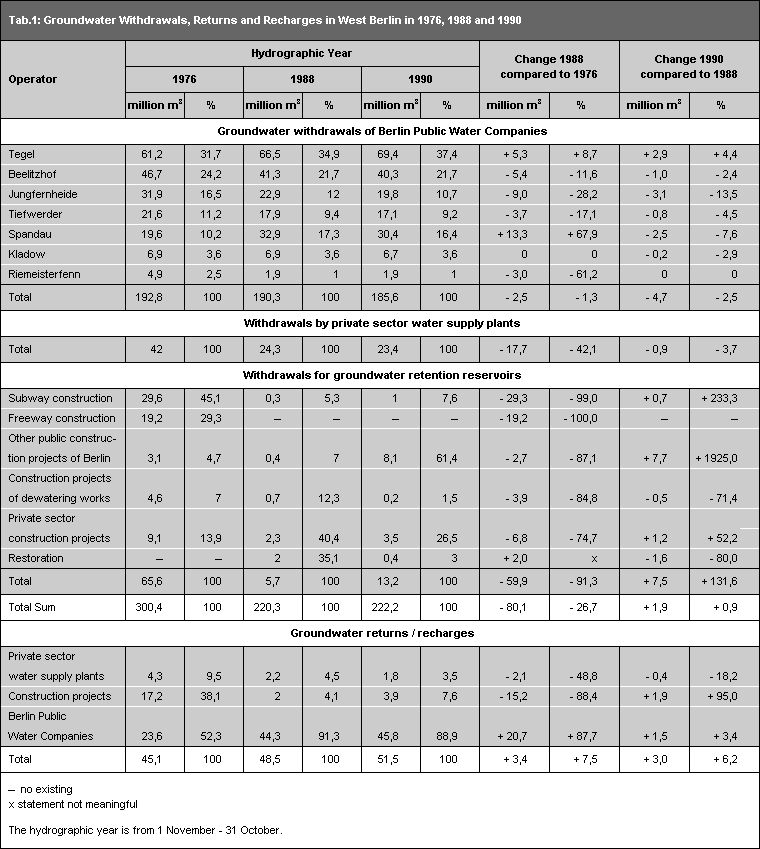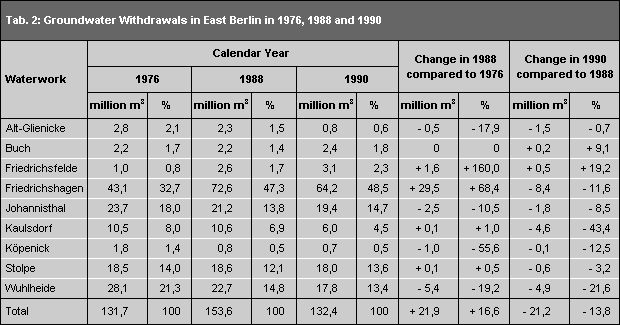No depiction of the entire East Berlin area is possible due to insufficient data bases. The low degree of expansion of the largest waterworks in Friedrichshagen is remarkable. In 1976 only the A-D galleries north of Müggelsee (see = lake) existed (cf. Map 01.22). The large plants south of the lake were put into operation between 1982 and 1984, with increased demands exerted by construction of the new residential areas of Marzahn, Hellersdorf and Hohenschönhausen as well as reduced surface water withdrawals from Müggelsee. The galleries which existed in 1976 withdrew about 14.6 million m3 raw water in May 1976, a record for this month. There are correspondingly large cones of depression around the waterworks.
Large construction projects in East Berlin with groundwater retention reservoirs were mainly in the Mitte borough, at the construction site for the Palace of the Republic, the Charité hospital, various hotels, and the expansion of the Friedrichstraße boulevard. No information is available for amounts withdrawn by private sector water supply plants.
Measures for groundwater recharge and return at construction projects for the stabilization of the groundwater economy were performed in the entire city. This amounted to about 45 million m3 in West Berlin, 52% of it around the Jungfernheide waterworks, which fed lakes Kuhlake and Saatwinkel. Another 38% were returned at construction projects (cf. Tab. 1). A groundwater recharge by means of an earth basin was performed in East Berlin around the Johannistal waterworks between 1972 and 1976. Infiltrated amounts in 1973 were 1.5 million m3. Groundwater has been recharged by the Stolpe waterworks into the bordering Havelwiese since 1974. The amounts flow to recharge by natural slope and amount to about 6 million m3/year.
Map 02.12.2: Groundwater Levels in May 1988 (relatively higher groundwater level)
In comparison to the strongly lowered groundwater levels in May 1976, the picture changed for large portions of Berlin, differing in both parts of the city.
Groundwater levels in West Berlin have risen again since the mid-80’s. That is mainly due to smaller groundwater withdrawals by private sector water supply plants, and lessened withdrawals by groundwater retention ponds and restoration/redevelopment projects. Compared to 1976, 78 million m3 less groundwater was withdrawn in 1988 (cf. Tab. 1). The considerable increase of 88% in groundwater recharge by the Berlin Public Water Companies compared to 1976 also contributed to relief of the groundwater economy. Withdrawal amounts of the Berlin Public Water Companies remained mostly unchanged compared to 1976; proportional amounts of individual waterworks have shifted.
This favorable development was supported climatically by mild months in winter and spring with high amounts of precipitation.
Changes in East Berlin in comparison to 1976 are especially noticeable in the Köpenick forest area. The expansion of the south gallery of the Friedrichshagen waterworks at the beginning of the 80’s led to cones of depression. In later years this also led to a deterioration of vegetation in individual wetlands.
There is no information for private sector water supply plants or groundwater withdrawals at construction sites in East Berlin in 1976. Withdrawal amounts in 1988 by private sector water supply plants obligated to payment (excluding hospitals, sports facilities, zoos and similar public facilities) were 12.9 million m3. About 12.7 million m3 were pumped out by construction projects. Extensive construction projects in the Mitte borough led to lowering of groundwater levels similar to 1976. The new residential areas of Marzahn and Hellersdorf, on the other hand, are located on the Barnim flat upland. No lowering of groundwater was required because there were greater groundwater depths from the surface.
Groundwater recharges in East Berlin around the Stolpe waterworks were about 5.6 million m3 in 1988.
Map 02.12.3: Groundwater Levels in May 1990
Groundwater levels in West Berlin changed only slightly in May 1990 compared to 1988. The hydrographical year 1990 was average climatically, with 628 mm of precipitation (measuring point Dahlem). Withdrawal amounts of public and private sector wells and groundwater recharges are at comparable levels (cf. Tab. 1). There were no important changes in groundwater tables.
East Berlin, including the Stolpe waterworks, showed a different development. East Berlin waterworks withdrew 31.3 million m3 less in 1990 than in 1989. This was a result of the economic effects of German reunification and the reduced commercial/industrial activity associated with it. The consequences of this reduction were smaller cones of depression around the galleries, and a more balanced situation with smaller gradients in the rest of East Berlin. Groundwater recharge in the Havel lowlands at the Stolpe waterworks remained unchanged at 6.2 million m3 compared to 1988.
The “transition situation” of this current time period will lead to a rise in demand due to new industrial parks and residential construction projects, especially in the east. Water consumption of the public water supply in West Berlin in 1990, including all groups of consumers, was 233 liters per inhabitant per day; in East Berlin 318 liters per inhabitant per day. The long-term goal is 240 liters per inhabitant per day.
The long-term assurance of a balanced groundwater economy requires such measures as:
- a more sparing use of drinking and industrial water
- increased groundwater recharge
- use of rainwater for industrial water purposes
- the de-sealing of surfaces.


